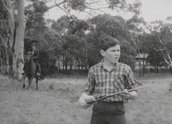

The Magic Boomerang – The Discovery (1965)
Synopsis
Thirteen-year-old Tom Thumbleton (David Morgan) lives with his parents (Penelope Shelton and Telford Jackson) on a homestead near the town of Gunnaganoo and Aboriginal reserve, 'Dreamtime Mountain’.
In this opening episode, the family is in danger of losing their farm and home when Tom’s greedy cousin Harvey (Fred Parslow) and sinister solicitor Smedley (Charles Haggith) threaten to take possession if the family cannot pay a debt. Tom finds a boomerang amongst some Aboriginal relics left by his great-great-grandfather in the attic and discovers that it has special powers – when thrown it can stop time.
Aided and abetted by his best friend Wombat (Rodney Pearlman) and a young Aboriginal boy, Milloo (Bindi Williams), Tom uses the magic boomerang to find treasure, foil Harvey’s plan and save the farm.
Curator’s notes
The premise of this adventure fantasy series is a mysterious magic boomerang handed down by Tom’s great-great-grandfather who, according to a letter Tom discovers in the attic, owes his life to the Aboriginal people who live at Dreamtime Mountain. Young Tom becomes the custodian of the boomerang and uses it over the 45 episodes of the series to foil the evil intent of various characters who threaten the idyllic life of the Thumbleton Homestead.
This first episode establishes the world from young Tom’s point of view. We also see the playful friendship between Tom and best friend Wombat. As the more mature of the two, Tom uses the boomerang and its powers with a sense of responsibility whilst Wombat enjoys playing tricks on the locals.
Set in the Australian bush, this groundbreaking children’s drama series centres on the lives of Australian kids. Leaving aside issues of authenticity, the program also features Aboriginal characters and recognises Aboriginal people as ‘the first people in Australia’ and the custodians of traditional knowledge.
As well as the appeal of seeing Australian characters and settings on the screen, producer Roger Mirams was also very aware of the potential for overseas sales. According to actor Gary Gray, Mirams has ‘always had an eye for what was “commercial”, so he’d change things if he saw something that he thought people overseas would like – scenery, or animals or whatever’. Gray adds, ‘[Mirams] capitalised on the Australian dream of kids riding horses and the Our Gang concept’.
Roger Mirams could be regarded as the pioneer of children’s television drama in Australia. Mirams produced, directed and shot The Adventures of the Terrible Ten (1960) and The Ten Again (1963) as forerunners to The Magic Boomerang. Pacific Films then moved to Woodend in Victoria and expanded to include two film units. All location filming was completed in and around Woodend, which the cast and crew dubbed 'Hollywoodend’.
Mirams produced a number of Australian children’s drama series, many of which were also sold overseas. These included Adventures of the Seaspray (1965-1967), The Adventurers (1968) and Woobinda, Animal Doctor (1968-69). More recently Mirams’ productions include Search for Treasure Island (1998-2000) and Escape of the Artful Dodger (2001) which he created, wrote and designed. Roger Mirams continued to work into his 80s; he died on 27 February 2004.
The Magic Boomerang was broadcast on the ABC on Sunday afternoons at 5.30 pm, from 2 May 1965. 'The Discovery’ is episode one of the first series. A total of 45 episodes was produced between 1964 and 1966, with 39 black-and-white episodes in series one and six colour episodes in series two. The series was sold overseas to territories including Britain, Canada and Malaysia.
Secondary curator’s notes
by Liz McNivenThe Magic Boomerang, an Australian children’s adventure series produced in 1965, appropriates an Aboriginal cultural object, the boomerang, and imbues it with a western concept of magic.
Aboriginal child actor Bindi Williams made his small-screen debut in the Magic Boomerang. With a lead role in the later television series Woombinda, The Animal Doctor (1968-69), followed by ongoing work in the industry, Williams soon became one of the best-known Aboriginal actors on Australian television.
The production’s representation of Aboriginal people as noble savages, living a traditional lifestyle at the Dreamtime Mountain reserve, reflects the outdated notion of a peaceful settlement as the overriding narrative describing the colonisation of Australia. By contrast, in the mid-1960s, Aboriginal people in Victoria no longer lived a traditional lifestyle. Their ancestors were forcibly removed from their lands, more than a century earlier, to make way for the white settlers.
Nevertheless, The Magic Boomerang holds a special place in the history of Australian television for its important contribution to the development of children’s television drama. It will be remembered fondly by many who viewed the series in their childhood.
- Overview
- Curator’s notes
- Video 2 clips
- Principal credits
- Find a copy
- Make a comment
- Map
- Add your review




